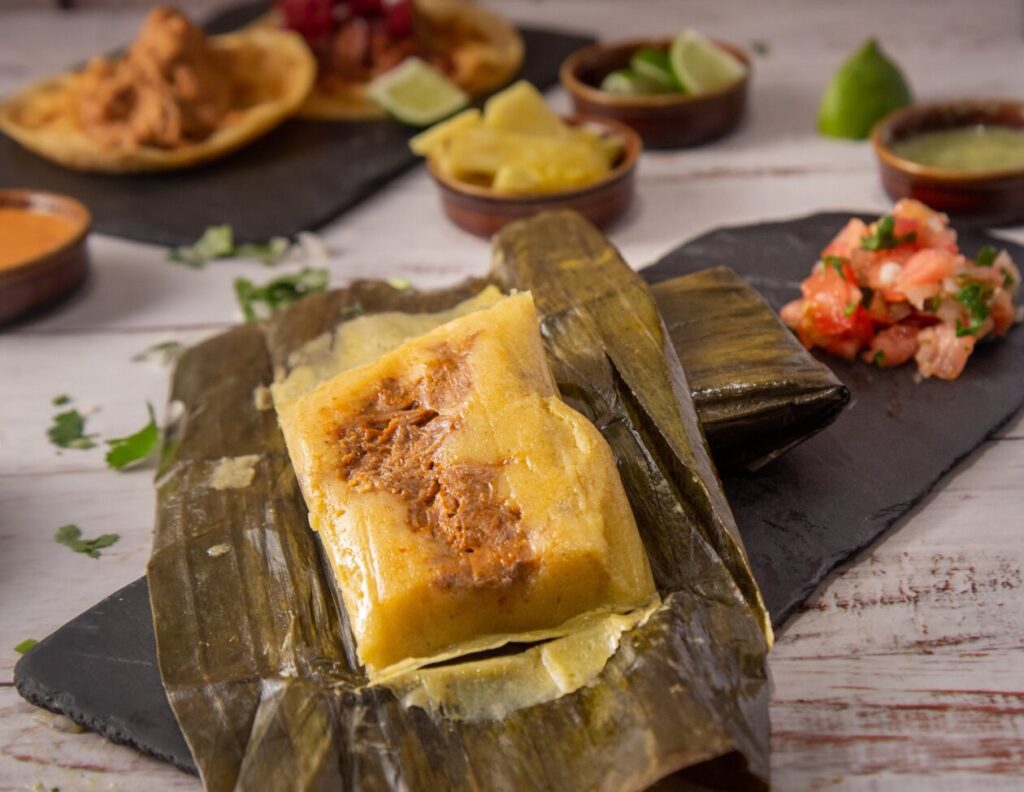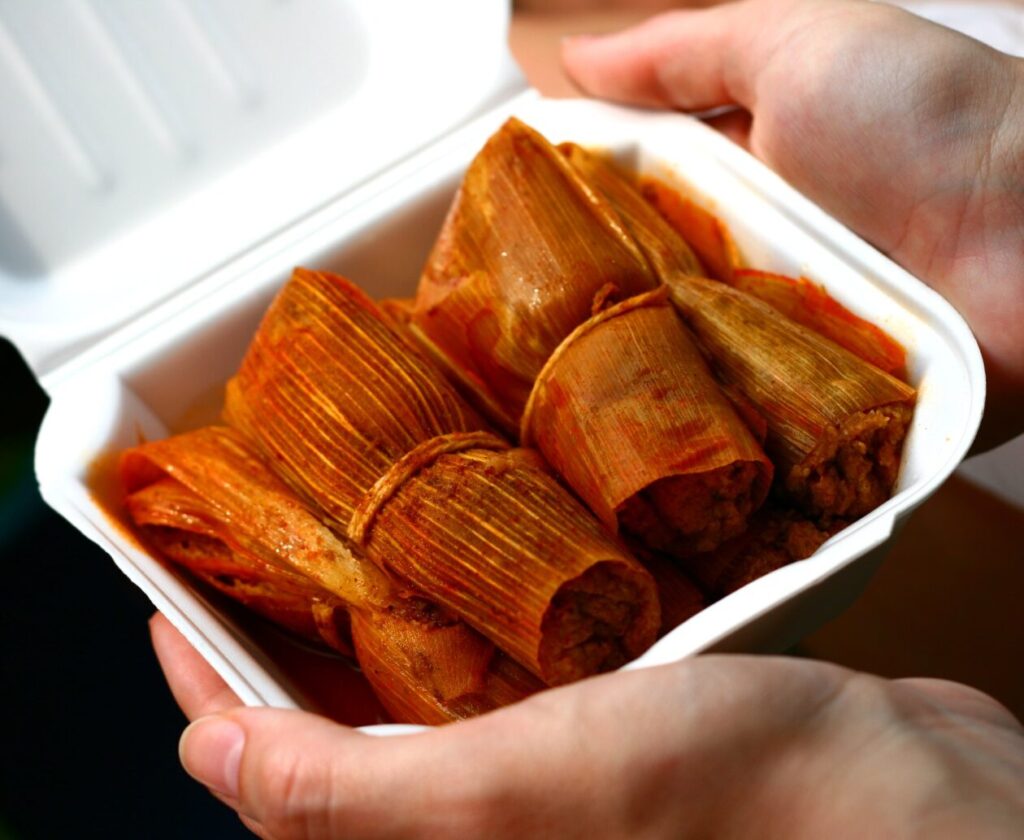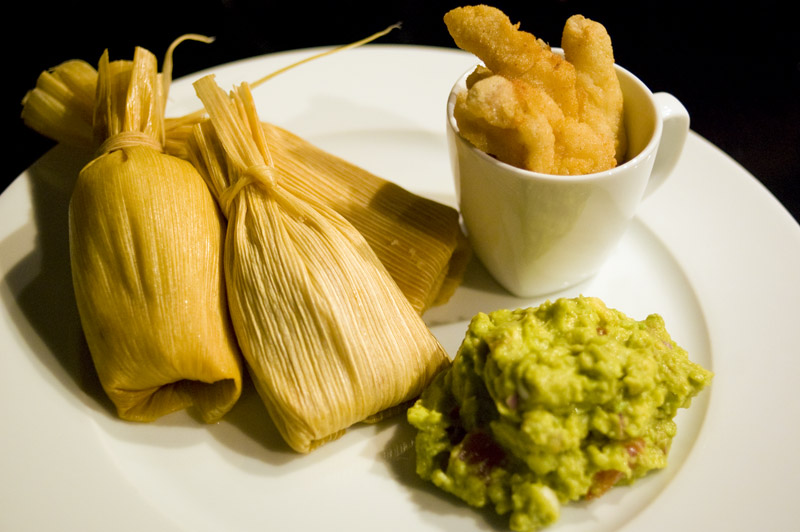Introduction
Tamales, a popular Mexican food with a long history, are deeply ingrained in the cultures of many different people. These delicious bundles of masa dough, packed with various savory or sweet fillings, are a testament to the rich culinary traditions and varied histories of places such as Mexico and Latin America. Tamales have endured as a beloved delicacy, frequently handed down through the generations, signifying togetherness, celebration, and culinary artistry, whether they are served for daily meals or celebratory festivities. However, many wonder, ‘Are tamales good for weight loss?’
Despite its deliciousness and cultural significance, people are curious about how well tamales fit into diet plans, especially those that aim to control weight. As we set out on our investigation, we’ll examine the nutritional makeup of tamales, assess how they could affect calorie intake, and discover ways to consume them to promote good eating habits. Come along as we reveal the truth about the relationship between tamales and weight loss.
Nutritional Analysis of Tamales
With their many fillings and rich history, tamales have a complicated nutritional profile. They usually include a combination of vital vitamins, proteins, lipids, and carbohydrates. Upon closer inspection, tamales have a moderate calorie density of about 153 calories per 100 grams. Their fat and carbohydrate content accounts for most of their calories. Therefore, portion control is essential for those trying to lose weight.
Tamales have a significant quantity of protein—roughly 6 grams per 100 grams—in addition to calories. Because of their high protein content, tamales may be a pleasing choice for people trying to lose weight but still want to preserve their muscular mass. In addition, tamales provide various micronutrients necessary for general health and well-being, including iron, calcium, and vitamins B6 and B12.
Although tamales are a great source of nutrients, there are certain issues for those trying to lose weight. One important factor is their comparatively high fat content—especially saturated fat. The fat content of tamales is increased by adding lard to the masa dough in traditional recipes. When overindulged, saturated fats can raise the risk of cardiovascular disease and make it more difficult to lose weight.
Furthermore, tamales could have high sodium content due to the addition of salt and seasonings. Excessive salt consumption may cause bloating and water retention, which may conceal weight loss efforts. Furthermore, because of their high-calorie content and mouthwatering flavors and textures, tamales can easily be overindulged in, which might unintentionally hinder weight loss efforts. To alleviate these worries, people trying to lose weight should approach tamales with awareness and consider better preparation techniques and ingredient replacements.
Nutrition Facts (USDA)
- Calories: 153 per 100 grams
- Total Fat: 6 g (9% Daily Value)
- Saturated Fat: 2.4 g (12% DV)
- Cholesterol: 17 mg (5% DV)
- Sodium: 427 mg (17% DV)
- Potassium: 131 mg (3% DV)
- Total Carbohydrate: 18 g (6% DV)
- Dietary Fiber: 3.1 g (12% DV)
- Granulated Sugar: 1 g
- Protein: 6 g (12% DV)
- Vitamins and Minerals:
- Vitamin C: 2% DV
- Calcium: 2% DV
- Iron: 6% DV
- Vitamin B6: 5% DV
- Cobalamin: 8% DV
- Magnesium: 5% DV
Percent Daily Values are based on a 2,000-calorie diet. Your daily values may be higher or lower depending on your calorie needs.
Health Benefits of Tamales

Beyond their delicious flavor and cultural importance, tamales provide many health advantages. Tightly packed with fiber, vitamins, and minerals, these salty morsels can enhance a well-balanced diet. Tamale-making corn masa is a good source of whole grains, supplying fiber that helps keep blood sugar levels stable and supports digestive health. Tamale’s nutritional value is further increased with lean meats, veggies, and beans, among other items.
The use of entire grains in tamales—mainly maize masa—is one of their most distinctive characteristics. Whole grains are highly praised for their ability to promote general well-being, weight control, and heart health. People can benefit from the nutrients found in real grain masa by eating tamales made with it. Whole grains provide a diversified microbiome, which is important for optimum immunological and digestive function and provides a consistent source of energy and satiety.
Furthermore, tamales are adaptable, fitting various nutritional requirements and preferences. Tamales cooked with lean protein sources, such as chicken or turkey, can be a quick and filling choice for anyone looking to gain muscle and improve their athletic performance. Tamale’s protein and carbohydrate content can help muscle repair and recovery after exercise. In addition, plant-forward diet enthusiasts can find fulfilling and nourishing meal options in vegetarian or vegan tamales packed with nutrient-dense ingredients, including beans, veggies, and plant-based proteins. Tamale recipes can be modified to satisfy various dietary objectives while providing a tasty taste and vital nutrients, whether consumed as part of an active lifestyle or as a plant-based meal.
Considerations for Weight Loss

Making wise ingredient selections is essential when incorporating tamales into a weight-loss program. Lean protein fillings like turkey or grilled chicken can drastically lower the total fat level while offering a good amount of satiety and nutrients that stimulate muscular growth. Adding a variety of veggies and legumes to the filling increases its flavor and texture while adding more fiber, making you feel fuller and supporting healthy digestion. Additionally, by including more fiber and important micronutrients, substitutes like whole-grain corn masa or flours like almond or coconut flour can improve the nutritional profile.
Mindful eating habits are essential to effective weight management, which is also true with tamales. Achieving desired results requires an understanding of appropriate calorie intake and portion proportions. Tamales can make a delicious part of a well-balanced diet, but moderation is the key. Overindulgence can be avoided, and weight loss objectives can be supported by keeping an eye on serving sizes and being aware of total caloric intake. Tamale dishes can be combined with other nutrient-dense meals to make a well-rounded meal that meets both hunger and dietary requirements, such as leafy greens, steaming vegetables, or a side salad.
The key to including tamales in a weight loss regimen is to strike a sustainable balance rather than just restricting yourself. People can stay motivated and enjoy their meals while pursuing their weight loss objectives by varying their meal options and including a range of nutrient-rich foods. When eaten in moderation and combined with a variety of complete foods, tamales can be a tasty and fulfilling part of a well-rounded diet. Ultimately, experimenting with various fillings, flavors, and cooking techniques can improve long-term adherence to good eating habits by keeping meals interesting and preventing monotony.
Alternatives and Modifications
Though tasty, tamales frequently contain components that might not be compatible with weight loss objectives. However, they can still be enjoyed as part of a balanced diet with careful adjustments. Vegetable oil is a healthier alternative to traditional lard that can drastically lower saturated fat without sacrificing flavor or texture. Tamale’s nutritional profile can be further improved by experimenting with vegetarian fillings or lean meat options like turkey or shredded chicken, which can provide plenty of protein to aid with weight loss. Additionally, lowering the sodium intake by using low-sodium foods or flavoring with herbs and spices rather than salt might help ease any worries regarding bloating or water retention.
Many inventive versions are available for even lighter alternatives to conventional tamales. Turkey tamale pie is one such choice; it has all the taste of authentic tamales but the ease of a casserole. This meal provides a tasty and healthy substitute for classic tamales by starting with lean ground turkey and layering it with corn masa and flavorful toppings like salsa and shredded cheese. Pies are a sensible option for anyone watching their calorie consumption because they simplify portion control. Ultimately, trying these healthier versions can allow you to savor tamales while assisting with your weight loss objectives.
The usefulness of tamales for weight loss ultimately depends on personal tastes, dietary constraints, and lifestyle decisions in general. While there are undoubtedly ways to make tamales a more suitable option for individuals trying to lose weight, it’s important to approach dietary options comprehensively. A successful weight-loss journey requires healthy meals, regular exercise, and mindful eating habits. You can discover a balanced strategy that supports your long-term health and wellness objectives and works best for you by experimenting with different recipes, paying attention to your body’s signs, and making educated decisions.
Cultural Significance and Moderation

In many communities, tamales are not merely a delectable food but a deeply symbolic representation of history and culture. Tamale making is deeply ingrained in Mesoamerican and Latin American traditions, and the recipes for these dishes are typically passed down through the generations. In addition to being delicious, tamales represent social events, family ties, and joyous occasions. Comprehending and valuing this abundant cultural legacy enhances the gastronomic encounter, cultivating a feeling of linkedness to the past and customs. In investigating whether tamales support weight loss objectives, it’s critical to acknowledge and respect their cultural significance in addition to taking dietary factors into account.
Given their high fat and calorie content, tamales are generally not linked to weight loss; they can still be included in a balanced diet when consumed in moderation. If one adopts a moderation perspective instead of seeing tamales as forbidden, cultural mainstays can be had without sacrificing health goals. Holidays and special occasions offer the chance to enjoy comfort foods like tamales while being conscious of portion sizes and total caloric consumption. By deliberately enjoying every bite and appreciating the flavors and textures, people can enjoy food satisfactorily without going overboard.
Including mindful eating techniques encourages a closer relationship with food and raises awareness of fullness and hunger indicators. Finally, mindfulness and moderation are compass points for negotiating the junction between cultural heritage and individual wellness objectives.
The inquiry on whether foods aid in weight loss emphasizes the significance of balance and personal preferences. Although tamales aren’t necessarily “good” or “bad” for losing weight, how they fit into a balanced diet depends on several variables, including their cultural importance, nutritional value, and individual dietary choices. People can embrace cultural traditions through moderation and mindfulness while maintaining a healthy balance between their food enjoyment and health. When consumed in moderation and with consideration, tamales may be a healthy addition to any meal, even those consumed on special occasions. Ultimately, developing a satisfying and long-lasting connection with eating habits requires finding delight in food while placing a high value on general well-being.
Are Tamales Good for Weight Loss?
A. Short Answer: While delicious and culturally significant, Tamales may not be the best choice for those aiming to lose weight due to their calorie and fat content.
B. In-Depth Analysis: Tamales, a cherished staple in many Latin American cuisines, are typically made with masa dough filled with various ingredients such as meats, cheese, or vegetables, then wrapped in corn husks or banana leaves and steamed. While they offer a rich and satisfying taste experience, their nutritional profile raises concerns for individuals focused on weight loss. Tamales are often high in calories and fats, particularly saturated fats from ingredients like lard or fatty cuts of meat. Additionally, traditional recipes may contain elevated sodium levels, contributing to water retention and bloating, potentially hindering weight loss efforts.
Despite these considerations, there are ways to enjoy tamales while prioritizing weight loss goals. Opting for healthier variations, such as using lean proteins like chicken or turkey and incorporating plenty of vegetables, can reduce calorie and fat content while boosting nutritional value. Additionally, selecting whole-grain masa or exploring alternative flours can enhance fiber content, promoting satiety and supporting digestive health. Portion control is also crucial; enjoying tamales in moderation as part of a balanced diet allows indulgence without derailing progress toward weight loss goals. Individuals can savor this beloved dish by making mindful choices and incorporating tamales into a comprehensive meal plan while prioritizing their health and wellness.
In summary, tamales may not be inherently conducive to weight loss due to their calorie and fat content, but they can still be enjoyed in moderation as part of a balanced diet. Individuals can incorporate tamales into their eating habits by making thoughtful ingredient choices, practicing portion control, and balancing cultural appreciation with dietary goals without compromising their weight loss efforts. Ultimately, it’s essential to approach tamales with mindfulness and moderation, savoring their cultural significance while prioritizing overall health and well-being.
FAQ Section
Are tamales high in calories?
Tamales can be relatively high in calories, especially made with ingredients like lard and fatty meats. The exact calorie content varies depending on the recipe and size of the tamale, but on average, one tamale can contain around 200-400 calories.
Are tamales junk food?
While tamales are traditionally made with wholesome ingredients like masa dough and various fillings, some variations may be considered junk food if they’re heavily processed or fried. Opting for homemade or freshly prepared tamales with nutritious fillings can make them healthier.
How many tamales should I eat?
The number of tamales you should eat depends on various factors, including calorie needs, dietary preferences, and overall health goals. As a general guideline, moderation is key. Enjoying one or two tamales as part of a balanced meal is usually sufficient.
How many tamales per person?
The ideal serving size of tamales per person can vary depending on appetite and dietary requirements. One to three tamales per person is a common serving size for a meal, but this can vary based on individual preferences and portion sizes.
How unhealthy are hot tamales?
“Hot tamales” typically refer to a spicy candy rather than a traditional Mexican dish. Hot tamales candies are high in sugar and artificial ingredients, making them a less healthy option than conventional homemade tamales.
Are tamales a meal or snack?
Depending on portion size and accompaniments, tamales can be enjoyed as a meal and a snack. When eaten in moderation with balanced fillings and sides, tamales can be a satisfying and nutritious meal option.
Are tamales good after a workout?
Tamales can be a source of carbohydrates and protein, which are beneficial for post-workout recovery. However, it’s essential to consider portion size and overall nutritional balance to ensure they fit within your dietary goals and preferences.
Are tamales bad for keto?
Due to their higher carbohydrate content, traditional tamales made with masa dough are unsuitable for a ketogenic (keto) diet. However, keto-friendly versions using alternative flours like almond or coconut flour may be available.
Why are tamales so good?
Tamales are cherished for their rich flavors, diverse fillings, and cultural significance. The combination of tender masa dough, savory fillings, and aromatic spices creates a unique culinary experience that appeals to many palates.
Are tamales high in sugar?
Tamales typically do not contain significant amounts of added sugar, especially if they’re made with savory fillings. However, some sweet tamale varieties may have sugar in the masa dough or sweet fillings.
Do tamales make you gain weight?
While tamales can be calorie-dense, enjoying them in moderation as part of a balanced diet is unlikely to cause weight gain. However, overconsumption or choosing high-calorie variations may contribute to weight gain.
Are corn tamales healthy?
Corn tamales can be a healthy choice with whole-grain corn masa and nutritious fillings like vegetables and lean protein. Corn masa is naturally gluten-free and provides essential nutrients like fiber and vitamins.
How many calories are in a tamale?
The calorie content of a tamale can vary depending on its size and ingredients. On average, one tamale can contain anywhere from 200 to 400 calories, with higher calorie counts for larger or more indulgent varieties.
Healthy tamales
Healthy tamales can be made using wholesome ingredients like whole-grain masa, lean proteins, and plenty of vegetables. Opting for steamed or baked tamales instead of fried versions can also reduce added fats and calories, making them a nutritious choice for any meal.
Conclusion
In conclusion, there is nuance to the topic “Are tamales good for weight loss?” Even though tamales are a tasty and important dish in some cultures, their ability to help people lose weight varies depending on several circumstances. Particularly when they are prepared with decadent fillings and conventional ingredients like lard, tamales can have a lot of calories and fat. But when cooked with plenty of veggies, healthful grains, and lean proteins, they can also be nourishing. If you’re trying to lose weight, Tamale eating must be done mindfully and in moderation.
Making educated food decisions is essential for weight loss. While tamales are occasionally a healthy diet element, it’s important to consider the ingredients, portion sizes, and overall nutritional balance. While still enjoying this popular dish, choosing homemade or healthier tamales—like those made with lean proteins and whole-grain masa—can help you achieve weight loss objectives.
In summary, tamales can be a delicious and nutritious diet, but moderation and attention are key. You may appreciate this traditional treat while putting your health and wellness objectives first by selecting nutrient-dense ingredients, controlling portion sizes, and serving tamales in moderation with other wholesome foods. Recall that no food is intrinsically “good” or “bad” for weight reduction; finding balance and making decisions based on your unique requirements and tastes are key. So go ahead and savor your tamales, but do so sensibly and with consideration for your general welfare.
Reference
FoodData Central. (2024). Usda.gov. https://fdc.nal.usda.gov/fdc-app.html#/food-details/167636/nutrients
J. Miller Jones. (2005). FIBRE AND WHOLE GRAINS AND THEIR ROLE IN DISEASE PREVENTION. Elsevier EBooks, 110–117. https://doi.org/10.1533/9781845690632.4.110
Margolis, L. M., Allen, J. T., Hatch-Mcchesney, A., & Pasiakos, S. M. (2020). Coingestion of Carbohydrate and Protein on Muscle Glycogen Synthesis after Exercise: A Meta-analysis. Europe PMC (PubMed Central), 53(2), 384–393. https://doi.org/10.1249/mss.0000000000002476
Bray, G. A., & Popkin, B. M. (1998). Dietary fat intake does affect obesity! The American Journal of Clinical Nutrition, 68(6), 1157–1173. https://doi.org/10.1093/ajcn/68.6.1157
Was this helpful?

Joseph Emb, RDN
Founder of StyleVitally.com | Registered Dietitian & Wellness Advocate
What I Cover:
I’m passionate about connecting nutrition science and everyday wellness to help people live healthier, more vibrant lives. I write about evidence-based nutrition, mindful eating, sustainable lifestyles, and holistic well-being at StyleVitally.com.
My Background:
The University of Texas in Austin, where I earned my Dietetics diploma, laid the groundwork for my nutrition and health career. My training and hands-on experience taught me the science and art of using nutrition to enhance health and well-being.
Professional Journey:
I’m an RDN with lots of experience. I’ve helped people seeking tailored nutritional recommendations in clinical settings and community outreach programs. My constant learning and professional development ensure that my recommendations are always based on the latest evidence.
Ethical Commitment:
My practice prioritizes integrity. My content is transparent and objective, following the most significant ethical standards. I can give my audience unbiased advice because I’m not affiliated with food businesses or industry associations. I want to help people make informed health decisions that match their values and ambitions.
Join Me on the Wellness Journey:
Join me on the path to vitality and well-being, whether facing nutritional issues, seeking sustainable lifestyle changes, or simply wanting a better, happier you. We’ll discover how diet, mindfulness, and holistic well-being can maximize your potential.









